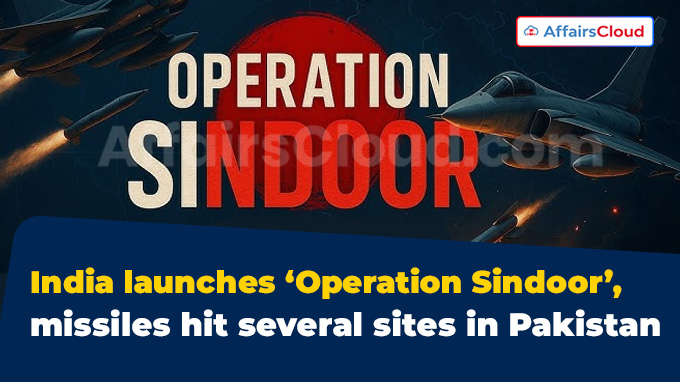 On May 7 2025, the Indian Armed Forces carried out ‘Operation Sindoor’, targeting nine terrorist camps in Pakistan and Pakistan-occupied Jammu and Kashmir (PoJK) which were identified as launchpads for attacks being planned against India. Operation Sindoor was carried out in response to the deadly terror attack in Pahalgam, Jammu and Kashmir (J&K) in April 2025.
On May 7 2025, the Indian Armed Forces carried out ‘Operation Sindoor’, targeting nine terrorist camps in Pakistan and Pakistan-occupied Jammu and Kashmir (PoJK) which were identified as launchpads for attacks being planned against India. Operation Sindoor was carried out in response to the deadly terror attack in Pahalgam, Jammu and Kashmir (J&K) in April 2025.
- The action was named “Operation Sindoor” to honour the women who lost their husbands in the Pahalgam terror attack which was termed as one of the biggest terror attacks after the abrogation of Article 370 in 2019.
About Operation Sindoor:
i.As part of the operation, nine places connected to terrorist activities were struck in Pakistan and PoJK. These strikes were done with care, avoiding any Pakistani military sites, and were launched from Indian airspace.
ii.India carried out 24 missile strikes across nine locations:
- Markaz Subhan Allah in Bahawalpur(Punjab, Pakistan)
- Markaz Taiba in Muridke(Punjab, Pakistan)
- Sarjal or Tehra Kalan(Punjab, Pakistan)
- Mehmoona Joya site in Sialkot(Punjab, Pakistan)
- Markaz Ahle Hadith in Barnala, Bhimber(PoJK)
- Markaz Abbas in Kotli(PoJK)
- Maskar Raheel Shahid in Kotli area(PoJK)
- Shawai Nallah camp in Muzaffarabad(PoJK)
- Markaz Syedna Bilal(PoJK)
iii.These locations were terror camps operated by groups like Lashkar-e-Taiba and Jaish-e-Mohammed.
iv.The Indian Air Force (IAF) used its frontline fighter jets to target terror camps without crossing the Line of Control (LoC). Rafale, Mirage 2000, and Su-30 MKI aircraft were involved in the operation.
- SPICE-2000 bombs were used for accurate strikes on the targets.
- Su-30 MKIs provided air defence support during the mission.
v.Two women officers Colonel Sofiya Qureshi and Wing Commander Vyomika Singh and Vikram Misri, Foreign Secretary, Ministry of External Affairs(MEA), jointly led the official media briefing on Operation Sindoor, marking a significant moment in Indian military history.
- Colonel Qureshi, from the Indian Army (IA) ’s Corps of Signals, became the first woman to lead an IA training team at the Force 18 exercise, the Association of Southeast Asian Nations(ASEAN) Plus multinational field training exercise. She was instrumental in planning and executing the operation.
- Wing Commander Singh, a decorated helicopter pilot in the IAF, contributed to the aerial strategies of the operation. She has flown both Chetak and Cheetah helicopters. Promoted to Wing Commander in 2017, she has also been a trailblazer for women in the IAF.
Missiles Utilized:
India has added many powerful and modern weapons to its defence forces in the past years. These are designed to strike targets with great accuracy, even from long distances. Some of the most important systems are:
i.AASM HAMMER: The Armement Air-Sol Modulaire(AASM) Highly Agile Modular Munition Extended Range(HAMMER ) bombs, made by the Paris ( France)- based aerospace company Saffron. It was launched from Rafale aircraft.
- This weapon can accurately hit targets up to 70 kilometres (km) away, works well in rough terrain, can be launched from low heights, and resists enemy jamming.
ii.SCALP Missile is a long-range cruise missile launched from fighter jets. It stands for Système de Croisière Autonome à Longue Portée – Emploi Général (EG), and in the United Kingdom (UK), it is called Storm Shadow. It is made by the Le Plessis-Robinson (France)-based company MBDA.
- SCALP can strike targets up to 450 km away with high accuracy, works in all weather, even at night, and is hard to detect due to its low-flying stealth design.
iii.METEOR is a cutting-edge European Beyond Visual Range Air-to-Air Missile (BVRAAM) system, made by MBDA company. It can hit enemy aircraft from a very long distance, even if they are not visible.
- Meteor uses a ramjet engine for continuous thrust, giving it a massive “no escape zone” to hit enemy aircraft at long ranges, even in heavy electronic warfare.
iv.The BrahMos Missiles is a fast cruise missile developed by New Delhi based BrahMos Aerospace Private Limited, a joint effort between India’s Defence Research and Development Organisation (DRDO) and Russia’s NPO (Scientific Production Association) Mashinostroyeniya (NPOM).
- It is used by all three branches of India’s defence forces. It uses the “fire and forget” system, flies up to 15 km high, drops to 10 metres (m) near the target, and carries a 200–300 kilogram (kg) warhead.
v.Anti-Tank Guided Missile(ATGM): ATGM is a precision-guided weapon designed to neutralize heavily armored military vehicles, such as tanks and fortified positions. Modern ATGMs often employ advanced guidance systems, including electro-optical imaging infrared (IIR) seekers, enhancing their accuracy and effectiveness.
- It is developed by DRDO and has a target range between 1.5 and 5 km.
vi.Loitering munitions are special types of drones that can watch over an area, find enemy targets, and then strike them with great accuracy, either on their own or with human control.
vii.’Sudarshan Chakra’ Missile Defense System: India’s S-400 systems successfully intercepted multiple incoming Pakistani missiles and drones, safeguarding critical military installations and civilian areas.
viii.Harpy : It is a loitering munition developed by Israel Aerospace Industries (IAI), specifically engineered for the Suppression of Enemy Air Defenses (SEAD).
- This autonomous, “fire-and-forget” system is designed to detect, track, and neutralize radar emitters, making it a formidable asset in modern electronic warfare.
ix.The IAI Heron (Machatz-1) is a Medium Altitude Long Endurance (MALE) unmanned aerial vehicle developed by the Malat division of IAI. Designed for extended surveillance and reconnaissance missions, the Heron is capable of operating at altitudes of up to 35,000 feet (10.5 km) and has demonstrated an endurance of up to 52 continuous hours.




